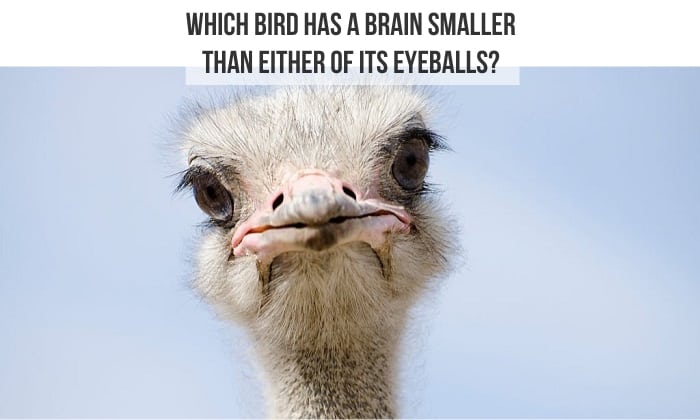
Have you ever wondered which bird has a brain smaller than either of its eyeballs? The answer is the ostrich. A bird that we associate with a long neck and long legs, but there are still a lot of facts about the ostrich.
The size of its eyeball is one of the most interesting features of this flightless bird, but there is more to it than meets the eye. Find out more as we discuss some facts about the ostrich.
Table of Contents
Ostrich Brain vs. Eye
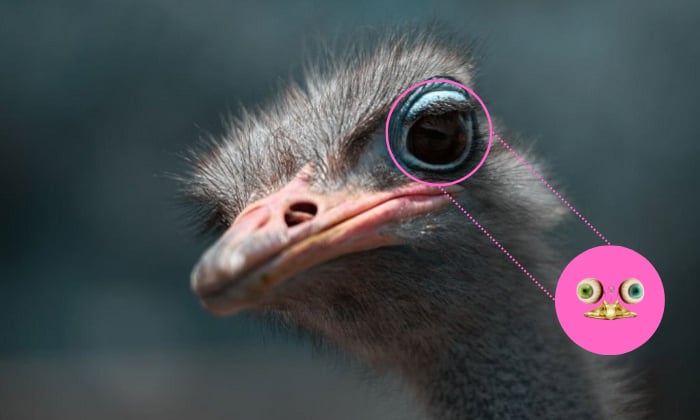
An ostrich has huge eyes; a common analogy compares them to the size of billiard balls. Even if they have smaller brains, their big eyes serve a purpose for their survival. They have existed for more than 120 million years, proving that you don’t need a big brain to survive and evolve into an extant species.
Because of this disparity in the size of the cerebrum and the eyes, the ostrich’s intelligence has always been called into question.
Pliny the Elder, a Roman naturalist and philosopher, once declared the ostrich stupid because of a disparaging account that they hide their heads in a bush or in the sand to escape predators.
This is not true, of course. This extraordinary bird only instinctively lies flat on the ground and stretches its neck parallel to the ground to hide from danger.
It may not be fair to judge this long-surviving species based on some ancient writing when modern scientific observations have revealed many superior qualities of the ostrich such as its eyesight.
The Ostrich’s Eye
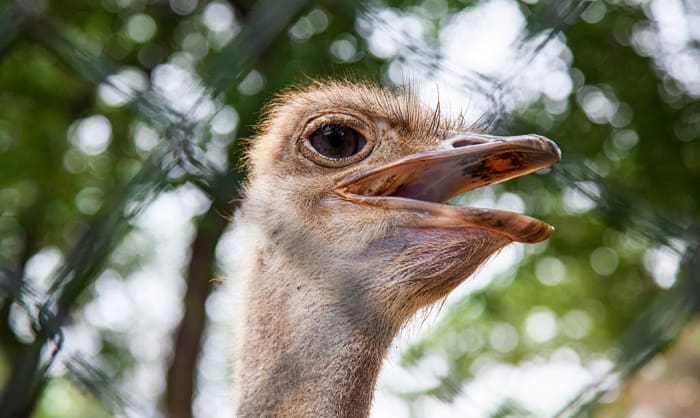
The ostrich being the world’s most giant bird, also takes the trophy for having the biggest eyes. The ostrich’s eye size is 5x bigger than the human eye. Wow! The size of each eyeball is even greater than the size of its brain.
Compared to other vertebrate animals, the ostrich’s eye is the largest, not just among birds. It has an axial length of around 39mm, or 1.5 inches to 2 inches (50mm) on average. The axial length is the distance between the eye’s front and back parts.
The huge eyes of the ostrich are indeed high-resolution, as expected of birds with big eyes, according to studies on different bird species and their visual capacities. Albeit, in general, an ostrich’s eye is more sensitive rather than high-resolution when compared to an eagle’s eye.
The Ostrich’s Brain
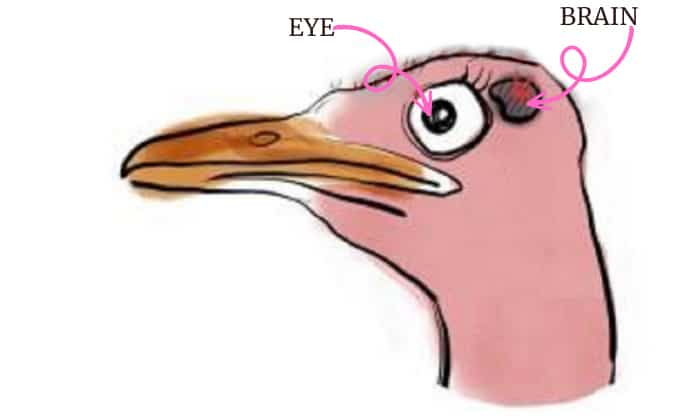
Based on studies of Ostrich brain size, the mean length is 2.3 inches, and the width is around 1.5 to 1.7 inches. Compared to the anatomy of the eye in terms of size, thus the ostrich’s eye is bigger than its brain in terms of width.
The weight of their brain is also very light, approximately 0.9 0z (26.34 grams), and makes up only about 0.015% of their entire body weight. When compared to other bird species, it is almost 17x lighter compared to three common domestic fowl species (26 grams).
Furthermore, The skull has large bilateral sockets for the eyes.
Ostrich Facts
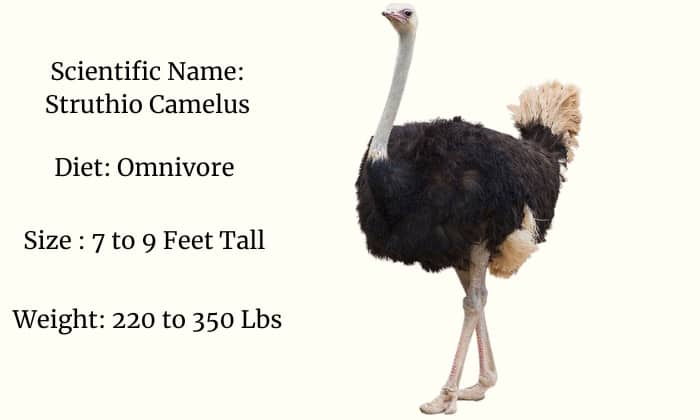
| Common Name: | Ostrich |
| Scientific Name: | Struthio Camelus |
| Order: | Struthioniformes |
| Family: | Struthionidae |
| Diet: | Omnivore |
| Size: | 7 to 9 feet tall |
| Weight: | 220 to 350 lbs. |
Fact #1. The ostrich is the largest of all the bird species in the world. Check out the summary of ostrich information above on its specific height and weight.
Fact #2. They are flightless birds, but they are winners when it comes to running! They can run as fast as 43 miles per hour and can cover a distance of 31 miles an hour.
Fact #3. They have very powerful legs that allow them to run fast and use as self-defense. Their kick is strong enough to kill, plus their toes are equipped with a 10-centimeter claw.
Fact #4. Aside from being the largest and one of the fastest birds, ostriches also lay the biggest eggs in the world. The average size of their eggs is 15 centimeters in length, and they can weigh up to 1.5 kilograms.
Fact #5. Ostriches are social animals. They live in a group called a herd with an average of 12 members. The alpha males of the group compete with each other to mate with the females in the group.
Fact #6. They have a very long gastrointestinal tract: the intestines of the ostrich are 46 feet long. This allows their gut to absorb its tough diet, which consists mostly of plant materials such as seeds, fruits, grass, leaves, and flowers. They sometimes eat insects such as lizards and locusts.
Fact #7. Most birds have three toes on their legs. The ostrich has two toes on its foot with claws attached to it.
Pros and Cons of a Smaller Brain

An ostrich has a huge body. It weighs around 159kg and stands very tall at around 2.7m. As discussed in the previous sections, it has a small brain relative to its body size. According to some studies, survival is not always about brain size. Having a small brain has its benefits and letdowns.
- Birds with small brains develop their strategies for survival. They may not be the smartest, but they can be the most resilient and persistent.
- The brain needs a lot of energy; having a small brain means that the demand for energy from the cortex is lesser compared to having a bigger one thus, the nutrients they consume can be focused on other areas like their limb muscles in the case of ostriches.
- According to studies, most animals with smaller brains have higher reproductive rates, ensuring the survival of their species.
- Because the brain is responsible for higher or more complicated functions, birds with smaller brains have limited behavioral responses. They are not as logical as other big-brained species and have limited memory. The ostrich has a memory span of 10 seconds.
- Species with small brains have difficulty adapting to certain conditions, such as temperature, food shortage, and altitude, compared to those with bigger brains.
Conclusion
When it comes to the ostrich, there are so many superlatives to describe its qualities as a species in terms of its body size, eye anatomy, egg size and its famous running speed.
There is more to discover about the ostrich than just knowing that it is the answer to this favorite question: which bird has a brain smaller than either of its eyeballs? You will agree that the size of the brain does not limit the ostrich from being an incredible bird.

George and I became friends after a birdwatching trip with our new group. And we have been enjoying every adventure together. When he told me the idea of establishing a site that shares our experiences and fun, I immediately agreed. After trials and errors, here we have Thayerbirding.













